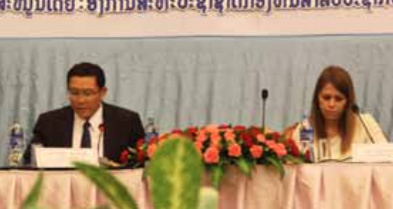With more than half of the population below the age of 25, the Lao government needs to take advantage of the demographic bonus and address inequality and disparities between ethnic groups and geographic areas.
The United Nations Population Fund (UNFPA) Deputy Representative of Laos Ms Ulrika Rehnstrom made the statement during a high-level forum held on Friday.
I am calling for empowering of young people in a holistic manner especially young women and adolescent girls. They deserve special attention and support in grabbing opportunity and claiming their rights, Ms Re hnstrom said.
I hope that public policies including the revised population policy will take the needs of young people into account, particularly adolescent girls.
The objective of the forum was to discuss population policy, in particular the potential future dividend of the demographic opportunity that can help the country achieve inclusive and sustainable growth.
Knowing the population structure is vital for designing effective policies and programmes. The population policy can help us achieve more sustainable and inclusive development, Deputy Minister of Planning and Investment Dr Kikeo Chanthaboury said.
To ensure benefits from population dynamics, Dr Kikeo stated the ministry was planning to start the revision of the National Population and Development Policy starting in 2017 using new and updated evidence, such as the Population and Housing Census 2015.
The 2015 Population and Housing Census showed the large generation of young people. About 60 percent of the total population is below the age of 25.
Organising this discussion highlights the government’s efforts in bringing population dynamics into socio-economic development of the country, Dr Kikeo added.
The recent Population and Housing Census 2015 indicated a continued growing population from 4.5 million in 2005 to 6.5 million in 2015. However, the population growth rate declined to 1.4 percent per annum between 2005 and 2015.
The average number of children per women decreased to 3.2 at present from 6.4 in 1985. These provide both opportunities and challenges for the country’s development.
The population aged 10-24 accounts for 32 percent. The work age population continues to rise from 57 percent in 2005 to 64 percent in 2015.
Fertility and mortality continue to decline. These features provide Laos with unique opportunities and challenges for the country, according to UNFPA.
The Lao government after adopting its commitment to the International Conference on Population and Development developed the National Population and Development Policy in 1999 aiming to ensure a balance between population and development and improve the life of people.
The policy was revised in 2006. After 10-years of its implementation, the Ministry of Planning and Investment, therefore, would like to take stock and revise the policy to meet the current population and socio-economic context of the country.
The forum was organised by the Ministry of Planning and Investment with support from UNFPA.
Source: Vientiane Times



